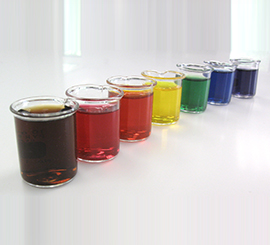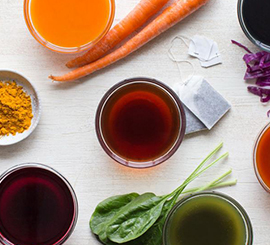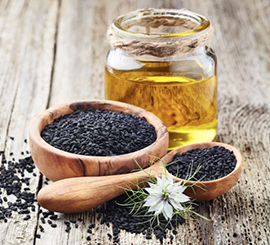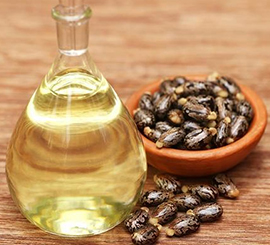Caramel Colour – E 150
Caramel Colour is prepared by heating food-grade carbohydrates under a controlled environment. Using different types of food grade acids, alkalis or salts, different classes and types of Caramel Colour can be made. All these different types of Caramel Colour are identified in suffix E 150 a,b,c and d.
Product Forms Available –
- El50a Plain Caramel Colour (Class I)
- E150b Caustic Sulphite Process Caramel Colour (Classll)
- El50c Ammonia Process Caramel Colour (Class III)
- E150d Ammonia Sulphite Process Caramel Colour (Class IV)

Caramel Colour has excellent stability in heat light & pH.
Recommended Dosage Level.
Between 0.01% to 0.1%, depending on the required color shade.
| Common Applications of Caramel Colour E150 | ||
|---|---|---|
| Cola drinks | Beer | Ice tea |
| Baked foods | Protein drinks | Soya sauce |
| Seasonings | Confectionery | Cookies / Biscuits |
| BBQ sauce | Chocolates | Candy / Licorice |
| Cocca powder | Brandy | Dairy products |
| Chocolate drinks | Cocca powder | Gravy mixes |
| Malt drinks | Cereals | Bread |

Caramel Powder – E 150
By using a unique low-temperature Spray Drying Technology, Liquid Caramel Colour is further spray dried to obtain Caramel Powder. Compared to Liquid Caramel, Caramel Powder offers complete versatility to a user in terms of application and dosage level.
Caramel Powder finds special application in products that are sensitive to moisture like Seasonings and Chocolate / Malt Drink Powders.
Product Forms Available –
- E150b Caustic Sulphite Process Caramel Powder (ClassII)
- E150c Ammonia Process Caramel Colour Powder (Class III)
- E150d Ammonia Sulphite Process Caramel Powder (Class IV)
Recommended Dosage Level.
Between 0.01% to 0.1% depending on the required color shade.
| Common Applications of Caramel Powder – E 150 | |
|---|---|
| Chocolate drinks | Cocoa Powder |
| Seasonings | Confectionery |
| Malt drinks | Gravy mixes |
| Baked foods | Cereals |
| Protein drinks | Ice tea |
| Confectionery | Cookies / Biscuits |
Curcumin Colour – E 100
Curcumin is the principal pigment of turmeric, a spice that is obtained from the rhizomes of Curcuma longa. Obtained by extraction from the plant to produce an oleoresin which is then purified, curcumin provides a bright, strong yellow shade.
It is an oil-soluble pigment that is available in convenient water-dispersible forms that are used in a wide range of foods
Curcumin is extremely heat stable and may generally be used in products throughout the acid pH range. Curcumin gives out a very intense color with bright yellow appetence even at low doses.
Product Forms Available –
- Water Soluble Liquid and Powder – 5% to 10%
- Oil Soluble Liquid and Powder – 5% to 10%

Recommended Dosage Level.
Between 0.01% to 0.1% depending on the required color shade.
| Common Applications of Curcumin Colour – E 100 | ||
|---|---|---|
| Cereals | Ice cream | |
| Icing | Salad dressing | |
| Chewing gum | Baked goods | |
| Yogurt | Dairy products | |
| Fruit preps | Dry soup premix | |
| Confectionery | Seasonings | |
| Pickles | Mustard | |
| Margarine | Jam | |

Annatto Colour – E 160
Annatto Colour is extracted from the seeds of the annatto bush called Bixa Orellana. These seeds give two pigments, bixin which is oil soluble and norbixin which is soluble in water.
Traditionally norbixin was used in cheese colouration, but gradually it started being used in a wide range of applications in different products. Whereas bixin, being Oil Soluble is used in cream fillings for biscuits, margarine, butter, low-fat spreads, and other fat-based products.
Annatto Colour has good stability towards heat and light.
Product Forms Available –
- Water Soluble in Liquid – 10%
- Water Soluble in Powder – 20%
- Oil Soluble in Liquid – 10%
- Emulsions Oil and Water Miscible – 4%
- Water Soluble Acid Proof Liquids – 4%
Recommended Dosage Level.
Between 0.01% to 0.1% depending on the required color shade.
| Common Applications of Annatto Colour – E 160 | ||
|---|---|---|
| Cheese | Margarine | |
| Butter | Ice cream | |
| Cereals | Salad dressing | |
| Dairy application | Meat products | |
| Baked goods | Dry soup premix | |
| Gravy mix | Seasonings | |
Red Beet Root Colour – E 162
Red Beet Root Colour is obtained from Beet Juice extracted from the roots of the vegetable called Beta Vulgaris. The Pigment present in the beetroot is known as betalains which is further classified in Red Betacyanin which gives the red colour. Beet Root Red gives a bright red to bluish-red colour depending on application and pH
Beet Root Colour is sensitive to heat and prolonged heating above 90 C will result in degradation of colour.
Product Forms Available –
- Water Soluble Powder – 0.35 % to 0.55% Betanin
- Recommended Dosage Level
- Between 0.01% to 0.1% depending on the required color shade

Recommended Dosage Level.
Between 0.01% to 0.1% depending on Product Strength.
| Common Applications of Red Beet Root Colour – E 162 | ||
|---|---|---|
| Yoghurt | Dry soup premixes | |
| Confectionery | Dry fruit drink premix | |
| Ice cream | Dry milkshake premixes | |
| Frozen dessert | Pharmaceuticals | |
| Fruit preparation | Packet mixes | |

Anthocyanin Colour – E 163
Anthocyanins are water-soluble compounds responsible for the red to blue color of a wide range of fruits and vegetables. They can be sourced from a wide variety of fruits, and vegetables. However, largely Grapes, Berries, and Black Carrots are used to derive the color.
Anthocyanin color is considered to be very versatile and easy to use. It is largely used in Soft Drinks, Jams and Jellies, Sugar Confectioneries and Frozen Products.
Product Forms Available –
- Water Soluble Powder 2%
Recommended Dosage Level.
Between 0.01% to 0.1% depending on Product Strength.
| Common Applications of Anthocyanin Colour – E 163 | ||
|---|---|---|
| Soft drinks | ||
| Jams and Jellies | ||
| Sugar confectioneries | ||
| Frozen Products | ||
| Wine | ||
Chlorophyll Colour – E140/141
Chlorophyll is the most widely distributed natural plant pigment, present in all green leafy vegetables & widely used as colouring matter for various food items. Chlorophyll is an oil-soluble color that can be extracted from a range of green leaves, but usually grass, nettles or alfalfa is used.
Chlorophyllin is obtained by the coppering of chlorophyll following its alkaline hydrolysis. This is a water-soluble colour and provides a green/blue to yellowish-green colour.
The improved stability and brightness of copper chlorophyllin lead to its much wider use than chlorophyll as a food color.
Product Forms Available –
- Water Soluble Liquid – 6%
- Oil Soluble Liquid – 6%

Recommended Dosage Level.
Between 0.01% to 0.1% depending on the required color shade.
| Common Applications of Chlorophyll Colour – E140/141 | ||
|---|---|---|
| Dairy products | Sauces | |
| Confectionery | Dry milkshake premixes | |
| Ice cream | Pharmaceutical products | |
| Frozen dessert | Beverages | |
| Fruit preparation | Herbal products | |
Colour Shades
| E Number | Color | Light | Heat | Alkali | Acid | Oxidation / Reduction |
|---|---|---|---|---|---|---|
| E 100 | Turmeric | Poor | Good | Fair | Good | Fair |
| E 160b | Annatto | Fair | Good | V. Good | Precipitates | Fair |
| E 162 | Beetroot Red | Poor | Poor | Poor | Fair | Fair |
| E 163 | Anthocyanin | Good | Good | Poor | V. Good | Good |
| E 140 E 141 |
Chlorophyll Copper Chlorophyllin |
Poor V. Good |
Poor V. Good |
Fair V. Good |
Precipitates Precipitates |
Poor V. Good |
| E 150 | Caramel | V. Good | V. Good | V. Good | V. Good | V. Good |
Vegetable and Condiment Powders
Farm Fresh Vegetable & Spices are processed using unique low-temperature spray drying technology to make Natural Vegetable & Condiment Powders. The gentle spray-drying process helps us retain the freshness, taste, and aroma of actual Vegetables and Spices. These Vegetable & Condiment Powders are natural in origin and are widely used in different types of Snacks, Seasonings, and Food Products.
Vegetable Powder
- Spinach Powder
- Carrot Powder
- Tomato Powder
- Ginger Powder
- Mint Pow Green Chilly Powder
- Coriander Powder
- Garlic Powder
- Onion Powder

| Common Applications of Vegetable and Condiment Powders | |||||
|---|---|---|---|---|---|
| Soup Mixes | Seasonings | Baby Food | Gravies | Curries | Flavor Powders |

Tomato Powder
Tomato Powder is one of the most widely used Vegetable Powders in the world market with versatile applications in a host of Food Products. Aarkay offers a premium range of Tomato Powders made from fresh and choicest tomatoes using our unique low-temperature spray drying process.
Whether it is purity for Baby Foods, Flavor and Colour for Seasonings, or Taste and Disperse ability for Soup Mixes, our Tomato Powders match all these different requirements.
| Common Applications of Tomato Powder | |||||
|---|---|---|---|---|---|
| Baby Food | Soup Mixes | Seasonings | Curries and Gravies | Snack Foods | Sauces and Purees |
Fruit Powder SX
Natural Fruit Powders
An accurate selection of Fruits followed by a gentle spray drying process ensures that you get unmatched freshness and taste in our Natural Fruit Powders. These Fruit Powders do not contain any synthetic additives and are free from harmful chemicals.
Fruit Powders have a very versatile application and can be used to substitute actual Fruits in different Food and Beverages. Year-round availability, storage convenience, longer shelf life, and versatile applications are some of the advantages that Natural Fruit Powders offer to the users.
Product List
- Strawberry Powder
- Orange Powder
- Mango Powder
- Apple Powder
- Pineapple Powder
- Lemon Powder
- Banana Powder
- Papaya Powder
- Pomegranate Powder
- Watermelon Powder
- Guava Powder
- Custard Apple Powder Amla Powder I Sapota (Cheeku) Powder

| Common Applications of Fruit Powder | |||||
|---|---|---|---|---|---|
| Beverages | Confectioneries | Baby Food | Nutraceuticals | Sweets | Milk Shakes, Jams |
| Jellies | Ice Creams | Baked Products | |||







